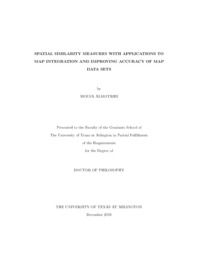
ATTENTION: The works hosted here are being migrated to a new repository that will consolidate resources, improve discoverability, and better show UTA's research impact on the global community. We will update authors as the migration progresses. Please see MavMatrix for more information.
Show simple item record
| dc.contributor.advisor | Elmasri, Ramez | |
| dc.creator | Almotairi, Mousa Alhajlah | |
| dc.date.accessioned | 2022-02-10T17:29:01Z | |
| dc.date.available | 2022-02-10T17:29:01Z | |
| dc.date.created | 2019-12 | |
| dc.date.issued | 2019-12-03 | |
| dc.date.submitted | December 2019 | |
| dc.identifier.uri | http://hdl.handle.net/10106/30255 | |
| dc.description.abstract | These days we live in a digital era where most societies rely on applications that depend on digital data. One popular type of digital data that is the basis many of applications is spatial data. Road network maps are one of the spatial data sets that are available for many important applications. However, acquisition of Road Network maps is an expensive task in terms of cost and time, not to mention the maintenance and the updating costs on these spatial data sets. In addition, each Road network map is captured for specific applications such as: road navigation, topographic cartography for printing maps, and so on. Thus, each application focuses on some aspects of the real-world while other aspects are ignored or not given sufficient attention. In order to tackle this problem, this dissertation provides a solution to utilize existing Road network maps by integrating them with one another. However, there is a high chance of mismatches between various road maps that represent the same area for many reasons. These reasons include but are not limited to the following: one of the datasets is not up to date; datasets have different names for the same road; the co-ordinates or features of road segments are not identical in the two maps; and so on. As a result, matching the roads in such datasets with each other is a challenging task. This dissertation introduces a framework that demonstrates methods of how two map datasets for the same area can be matched to each other even though there are some data discrepancies. In addition, it gives an overview of each component of the framework and focuses mainly on the similarity measurements. These measurements are local divergence measurements and global divergence measurement. Local divergence measurements compare two roads from different datasets to each other to see if they are similar or not by deciding if these two roads have a similar shape as well as the same length. On the other hand, global divergence measurement is used in order to ensure that these two roads are similar in the real world with respect to the location, not different roads that happen to be beside each other having similar length and shape. This dissertation discusses several types of applications that could utilize this framework not only for matching different road maps and unifying the information for smart cities usages but also for data enrichment purposes, historical datasets comparison, and ensuring that maps are up-to-date. As an example, we compare a historical map of Tarrant County, Texas roads with a map of the same area after 11 years. We determine which subareas have grown by calculating the percentages of new roads in each subarea, as well as determining which roads have been taken off the map, for example for stadium construction or flood abatement. | |
| dc.format.mimetype | application/pdf | |
| dc.language.iso | en_US | |
| dc.subject | Smart Cities | |
| dc.subject | Spatial Databases | |
| dc.subject | Data Matching | |
| dc.subject | Road Similarity | |
| dc.subject | Road Networks | |
| dc.subject | Road Divergence | |
| dc.subject | Hausdorff Distance | |
| dc.title | SPATIAL SIMILARITY MEASURES WITH APPLICATIONS TO MAP INTEGRATION AND IMPROVING ACCURACY OF MAP DATA SETS | |
| dc.type | Thesis | |
| dc.degree.department | Computer Science and Engineering | |
| dc.degree.name | Doctor of Philosophy in Computer Science | |
| dc.date.updated | 2022-02-10T17:29:01Z | |
| thesis.degree.department | Computer Science and Engineering | |
| thesis.degree.grantor | The University of Texas at Arlington | |
| thesis.degree.level | Doctoral | |
| thesis.degree.name | Doctor of Philosophy in Computer Science | |
| dc.type.material | text | |
| dc.creator.orcid | 0000-0003-4799-6004 | |
Files in this item
- Name:
- ALMOTAIRI-DISSERTATION-2019.pdf
- Size:
- 35.12Mb
- Format:
- PDF
This item appears in the following Collection(s)
Show simple item record


